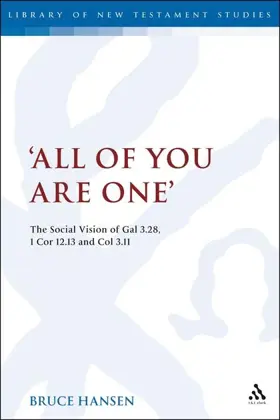

'All of You are One': The Social Vision of Gal 3.28, 1 Cor 12.13 and Col 3.11
in Library of New Testament Studies
Pages
256
Publisher
T&T Clark
Published
1/19/2010
ISBN-13
9780567136046
Hansen argues against prevalent views that the unity formula employed in Gal 3.28, 1 Cor 12.13 and Col 3.11 reflects either a Hellenistic anthropology of ideal androgyny or a modern liberal conception of social equality.
Rather, Hansen contends, attention to function and context demonstrates each epistle's vision of social unity. Insights from ethnic theory elucidate how epistles characterize this unity in terms of a new social identity, and the practices warranted by that identity. Furthermore, Hansen claims that because identity construction is continual, dynamic and discursive, alternate identities (e.g. ethnic, gender, religious, economic) within the new Christian communities, may be seen as influencing one another and may be termed as the collective Christian identity.
Hansen employs theories from Ethnic study as tools for assessing how such overlapping identities persist and interact with one another. His analysis thereby demonstrates that the social unity promoted by this formula opposes cultural dominance by any particular group and, conversely reinforces the persistence of marginal social identities within new communities. The issue is then not one of gender equality, but of the equality that Paul wishes to develop between competing social groups.
- Table of contents
- Acknowledgements
- Abbreviations
- Chapter One: Introduction
- I. The Formula
- a. Formal Observations
- II. Previous Interpretive Approaches
- a. Hellenistic Philosophy
- b. Gnosticism
- c. Paul's Response to Judaism
- III. Ethnic Unity and Paul
- a. Social Unity in Paul's Churches
- IV. Summary
- I. The Formula
- Chapter Two: Reading Paul Ethnically
- I. Defining Ethnicity
- a. The Need for Clarity
- II. Genealogy and Autochthony
- a. Genealogy and Autochthony in Paul
- III. Indices of the Genealogical Criteria
- a. Consubstantiality: Commensality, Connubiality and Common Cult
- IV. Ethnic Discourse
- a. An Example from Hellenistic Judaism
- V. Acculturation, Assimilation and Ethnogenesis
- VI. Summary
- I. Defining Ethnicity
- Chapter Three: Galatians 3.28 And The Household Of Faith
- I. Introduction: Galatians 3.28 in Epistolary Context
- II. Disunity in Jerusalem and Antioch: Galatians 2.1-14
- III. Paul's Speech: Galatians 2.14c-21
- IV. Urging Unity: Galatians 5-6
- V. Social Identity in Apocalyptic Perspective
- VI. Galatians 3-4: Identity and Unity in Christ
- a. Centrality of 3.28 to Galatians 3-4
- b. The Singular Identity of All in Christ
- 1. Heirs of Faithful Abraham
- 2. The Cross versus the Law
- VII. Ethnic Identity
- VIII. Summary
- Chapter Four: 1 Corinthians 12.13 And The Body Of Christ
- I. Introduction
- a. 1 Corinthians in Socio-Historical Context
- b. Unity as Ethnic Identity in the Letter Opening
- II. Ethnicity among Images for Unity
- a. h9 e0kklhsi/a
- b. Israel
- c. Building
- d. The Body of Christ
- 1. The Body and Sexual Union
- 2. The Body and Common Cult
- 3. 'Body' in 1 Corinthians 12 and 15
- e. Family and Household
- f. Summary: Ethnicity and Paul's Images for Unity
- III. Ethnic Identity and the Unity Formula in Paul's Parenesis: 1 Corinthians 5-14
- a. 1 Corinthians 5-7 1. 1 Corinthians 5.1-13 2. 1 Corinthians 6.1-11 3. 1 Corinthians 6.12-20 4. 1 Corinthians 7
- b. 1 Corinthians 8.1-11.1: Divisions over Idol Meat
- c. 1 Corinthians 11.2-14.40: Divisions in Worship
- 1. Divisions Arising from Social Status Conflicts
- 2. Ethnic Concord and the Body of Christ
- IV. Summary
- I. Introduction
- Chapter Five: Colossians 3.11 And The New Humanity
- I. Introduction
- II. Social Identity and Solidarity in Colossians 1.1-2.23
- a. Colossians 1.1-23: Prayer and Thanksgiving
- 1. Traditional Material in 1.13-20
- b. Paul's Exemplum: 1.24-2.7
- c. The Polemical Core: 2.8-23
- 1. Apocalyptic Disruption
- 2. The Body of Christ
- a. Colossians 1.1-23: Prayer and Thanksgiving
- III. Seeking Unity in Christ: 3.1-4.6
- IV. Unity as Ethnic Solidarity
- a. Ethnic Criterion of Genealogy
- b. Confirming Indices of Ethnicity
- 1. Boundaries
- 2. Kinship Norms
- 3. Household
- V. Summary
- Chapter Six: Conclusions
- I. The Aims and Methodology of this Study
- II. Conclusions of this Study
- a. Galatians 3.28 in Epistolary Context
- b. 1 Corinthians 12.13 in Epistolary Context
- c. Colossians 3.11 in Epistolary Context
- d. Synthesis
- Works Cited
- Ancient Texts
- Secondary Sources